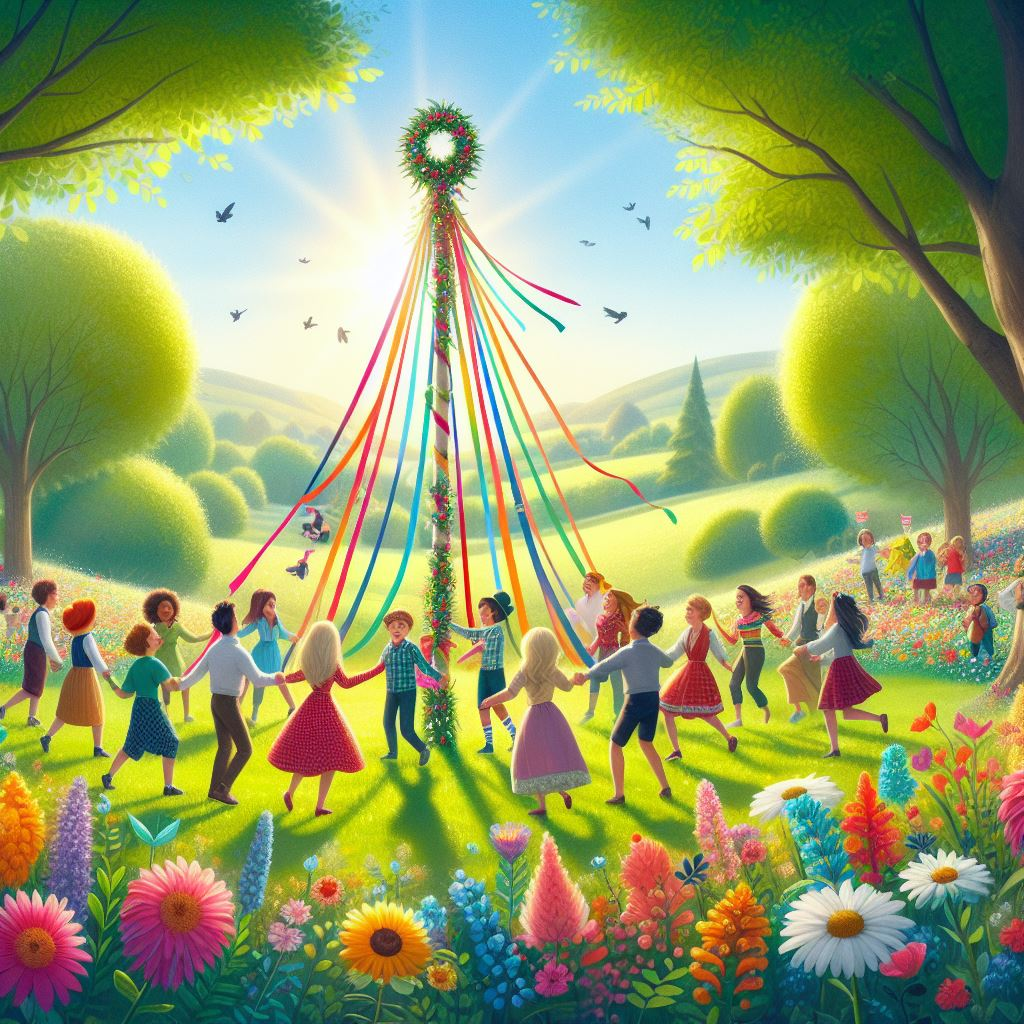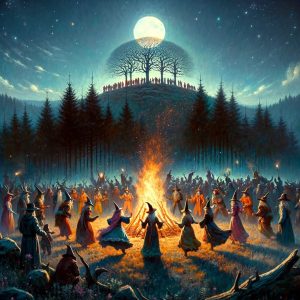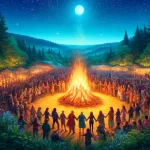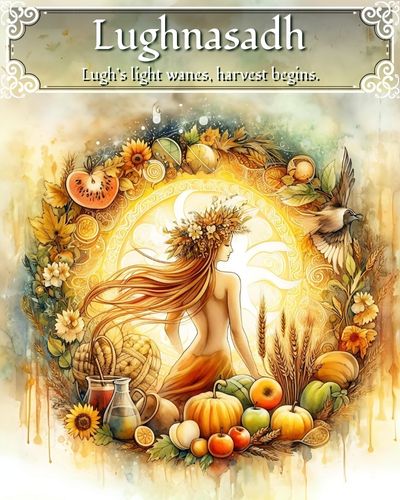
Approx. Reading time: About 11 Minutes

Introduction
Celebrating the Arrival of Spring with Joy and Tradition
May Day, a vibrant and ancient holiday, celebrates the arrival of spring with a sense of joy, renewal, and community. Often associated with colorful processions, dancing around the Maypole, and the crowning of a May Queen, May Day has a rich history and unique traditions. In this article, we will explore the origins and history of May Day, how it is celebrated in detail, and important safety considerations to ensure a safe and enjoyable experience for all.

History and Origins
May Day, a celebration with a rich tapestry of cultural and historical origins, draws upon ancient pagan traditions as well as more recent social and labor movements. Its roots can be traced back to the ancient Celtic festival of Beltane, which held profound significance in marking the midpoint between the spring equinox and the summer solstice.
Beltane, celebrated by the Celts, was a festival that embraced the rejuvenation of nature during the transition from spring to summer. The festival took place on May 1st and revolved around the theme of fertility and growth. It was believed that during this time, the spirits of nature were particularly active, and their presence was felt throughout the land.
Beltane was a joyous occasion when the community came together to honor the awakening of the earth and the onset of abundant harvests. The festival involved various rituals, including the lighting of bonfires as symbols of purification and protection. People would leap over the flames or drive their livestock between them, believing that this act would bring good fortune and protect against malevolent influences.
May Day’s connection to Beltane highlights the enduring human fascination with nature’s cycles and the desire to celebrate the changing seasons. The festival’s origins reflect the deep connection our ancestors felt to the natural world and their recognition of the importance of fertility and growth for their survival.
In addition to its ancient pagan roots, May Day also carries influences from more recent social and labor movements. In the late 19th century, the struggle for workers’ rights and better working conditions gained prominence, particularly in Europe and the United States. May 1st was chosen as International Workers’ Day, also known as Labor Day, to commemorate the historic struggle for the eight-hour workday.
This connection between May Day and workers’ rights underscores the holiday’s evolution beyond its ancient agricultural origins. It became a rallying point for labor movements, with workers marching in solidarity and demanding fair treatment, improved wages, and better working conditions.
May Day, with its multifaceted history and diverse origins, stands as a testament to the enduring human desire to celebrate the cycles of nature, honor the strength and resilience of the labor force, and recognize the interplay between the natural world and human society.
As May Day continues to be celebrated today, it encompasses a blend of ancient customs, labor movements, and a celebration of spring’s arrival. This rich tapestry of traditions reflects our ongoing connection to nature, our collective aspirations for justice and fairness, and our deep-rooted desire to gather as a community and rejoice in the beauty and abundance of the world around us.
May Day and Beltane
While May Day and Beltane share common threads, they have distinct characteristics that set them apart. Beltane, deeply rooted in ancient Celtic paganism, was closely intertwined with agricultural cycles, fertility rituals, and the veneration of nature deities. In contrast, the modern celebration of May Day has evolved to encompass a broader sense of community, a joyous celebration of spring, and the acknowledgment of workers’ rights.
Beltane, celebrated by the ancient Celts, was primarily focused on the agrarian way of life. It marked the midpoint between the spring equinox and the summer solstice, symbolizing the transition from the lighter days of spring to the sun-drenched abundance of summer. Beltane was intricately tied to the fertility of the land and the vital role it played in sustaining the community. Rituals and customs during Beltane were centered around ensuring bountiful harvests, fostering the growth of crops and livestock, and invoking blessings from nature deities associated with fertility and abundance.
In Beltane, sacred fires were a prominent element, representing the transformative power of the sun and the energy it infused into the earth. People would leap over or walk between these fires, symbolizing purification, and protection, while also seeking the blessings of the gods and goddesses for prosperity and fertility.
May Day, as celebrated today, retains some echoes of Beltane but has evolved to encompass a broader set of themes. The modern May Day celebration emphasizes community engagement, the vibrant arrival of spring, and the recognition of workers’ rights. While the ancient rituals of Beltane were tied to the agricultural cycle, May Day transcends this specific focus and has become a celebration of the changing seasons, the beauty of nature, and the spirit of camaraderie among people.
One of the most recognizable features of modern May Day celebrations is the tradition of dancing around the Maypole. This custom has roots in Beltane, where the maypole represented the potent phallic symbol of fertility. However, in the modern context, the focus has shifted towards communal participation, with ribbons woven around the pole by dancers in intricate patterns, symbolizing the interweaving of people’s lives and their connection to nature.
Furthermore, while Beltane had spiritual and mythological associations with nature deities, May Day today often embraces a more secular and inclusive spirit. It has become a time for communities to come together, organizing parades, festivals, and other public events that celebrate the beauty and vitality of spring. Additionally, May Day has also been embraced as a day to raise awareness of workers’ rights and advocate for social justice.
In summary, while May Day and Beltane share common origins and thematic elements, they have distinct emphases and cultural contexts. Beltane revolved around ancient Celtic pagan beliefs, emphasizing agricultural cycles and nature worship. May Day, on the other hand, has evolved into a more diverse and inclusive celebration of spring’s arrival, community cohesion, and the acknowledgment of workers’ contributions. Both festivals, in their respective eras, hold significance as cultural touchstones, reminding us of our deep connection to the cycles of nature and the enduring human spirit of celebration and solidarity.
May Day Celebrations
May Day, with its roots in ancient traditions and its vibrant evolution over time, brings communities together to celebrate the arrival of spring with exuberance and merriment. This section explores the diverse and enchanting ways in which May Day is celebrated, encompassing the lively and iconic customs of maypole dancing, the crowning of the May Queen, colorful processions and parades, and the energetic rhythms of Morris dancing. As the world awakens from winter’s slumber, these joyous May Day traditions ignite a sense of unity, renewal, and communal celebration, filling the air with laughter, music, and the spirit of spring’s boundless vitality. May Day celebrations vary across different cultures and regions, but certain elements are commonly observed. These include:
Maypole Dancing: Weaving Ribbons of Joy and Unity
One of the most captivating and beloved traditions of May Day is the enchanting dance around the maypole. This timeless custom has its roots in ancient pagan celebrations and continues to bring people together in a colorful display of unity and merriment. Standing tall and proud, the maypole is a beacon of celebration, adorned with ribbons and flowers that flutter in the gentle breeze.
As the festivities commence, participants, often dressed in vibrant attire, gather around the maypole. Each person takes hold of a ribbon, which is attached to the top of the pole. With hearts brimming with anticipation, they begin to move in a graceful dance, carefully navigating their steps and intertwining the ribbons as they circle around the pole.
The dance itself is a mesmerizing spectacle, as the participants weave intricate patterns with ribbons, creating a living tapestry of vibrant colors. With each step and twirl, the ribbons intertwine and interlace, symbolizing the unity of the community and the interconnection of all individuals. The dance becomes a celebration of togetherness, where the rhythmic movements and shared laughter fill the air with an infectious sense of happiness.
Maypole dancing is not merely a physical activity but a symbolic representation of the flourishing of nature and the human spirit. It captures the essence of the season’s renewal, reminding us of the interconnectedness of life and the harmony found in coming together to celebrate. Through the dance, participants embody the spirit of cooperation and unity, fostering a sense of camaraderie and shared celebration.
This cherished tradition has endured through the ages, transcending cultural boundaries, and captivating the hearts of people across the world. Whether in quaint village squares or bustling city parks, the sight of maypole dancing evokes a sense of enchantment and nostalgia, connecting us to our ancient roots and reminding us of the timeless beauty of community and the vibrant energy of spring.
Crowning the May Queen: An Emblem of Beauty and Fertility
In select communities, the tradition of crowning a May Queen adds an air of regality and grace to the May Day festivities. Chosen for her poise, charm, and embodiment of the spirit of spring, the May Queen holds a special role in the celebration. With reverence and admiration, she is adorned with a wreath of flowers, symbolizing the blossoming of nature and the vitality of the season.
The crowning of the May Queen is a moment of significance, steeped in tradition and symbolism. As the delicate floral crown is gently placed upon her head, the May Queen becomes a living embodiment of beauty and fertility, encapsulating the vibrant spirit of the season. Her presence radiates joy and hope, as she leads the community in the celebrations that honor the arrival of spring.
The May Queen’s role extends beyond her adornment and symbolic representation. She becomes a focal point of the festivities, leading processions, dancing, and engaging in communal activities. Her presence ignites a sense of enchantment and admiration, inspiring those around her to embrace the energy of the season and to revel in the bountiful gifts of nature.
The crowning of the May Queen is not only a celebration of an individual but also a recognition of the feminine qualities and the life-giving forces that permeate the world. It is a tribute to the nurturing and fertile aspects of nature and a reminder of the interconnectedness between humanity and the cycles of the natural world.
The May Queen’s grace and radiance serve as a guiding light, inspiring the community to appreciate the beauty that surrounds them and to celebrate the abundance that spring brings. Through her presence, the May Queen encapsulates the essence of the season, reminding all to cherish and honor the transformative power of nature’s rebirth.
Processions and Parades: A Vibrant Display of May Day Spirit
May Day comes alive with the vibrant energy of processions and parades that grace the streets with their enchanting presence. These colorful displays bring communities together in a joyous celebration of the season’s arrival. Participants, dressed in traditional costumes adorned with floral motifs, create a visual spectacle that captivates onlookers and ignites the spirit of May Day.
As the procession begins, the streets come alive with a kaleidoscope of colors and lively music fills the air. The participants, united in their shared enthusiasm, march in synchronized steps, their costumes reflecting the beauty and vibrancy of nature in full bloom. From flowing ribbons and floral headdresses to intricate embroidery and elaborate designs, the costumes evoke a sense of wonder and evoke the essence of the season.
Accompanied by music, singing, and dancing, the procession becomes a lively celebration, merging the visual splendor with the rhythmic beats and melodic tunes. The air is filled with infectious joy as participants and spectators alike join in the merriment, their spirits lifted by the collective revelry.
Processions and parades on May Day not only captivate the senses but also foster a sense of community and togetherness. They serve as a reminder of the shared values and traditions that bind people together, transcending generations and cultural boundaries. The procession becomes a visual narrative, weaving together the stories of the community’s past, present, and hopes for the future.
Through the vibrant processions and parades, May Day becomes a time of unity and celebration. It allows individuals to immerse themselves in the lively spirit of the season, to express their creativity through costumes, and to forge connections with their community. These colorful displays breathe life into the streets, serving as a testament to the enduring traditions and the collective joy that May Day brings.
So, as the procession moves through the streets, accompanied by music, singing, and dancing, let us embrace the magic of May Day, where communities come together to celebrate the beauty of spring, to honor the traditions that bind us, and to revel in the vibrant tapestry of life.
Morris Dancing: An Energetic Rhythm of Tradition
In certain regions, the tradition of Morris dancing brings an energetic and lively element to May Day celebrations. Rooted in folk traditions and passed down through generations, Morris dancers captivate audiences with their spirited performances. Dressed in unique and distinctive costumes adorned with bells, ribbons, and intricate designs, they showcase a fusion of music, dance, and rhythmic precision.
The Morris dance routines are a feast for the eyes and ears, filled with intricate footwork, leaps, and intricate patterns. The dancers move in synchrony, their steps precise and graceful, as they weave a captivating tapestry of rhythm and movement. With each step, the jingle of bells and the flutter of ribbons add an enchanting auditory element to the spectacle.
Costumes worn by Morris dancers vary from region to region, each reflecting local traditions and influences. Vibrant colors, flowing fabrics, and intricate embroidery lend an air of charm and authenticity to their attire. The combination of unique costumes and the rhythmic sound of the dancers’ movements creates a visual and auditory experience that is both mesmerizing and joyous.
Morris dancers often incorporate props into their routines, such as sticks, handkerchiefs, or swords, which add an additional layer of flair and complexity to their performances. These props are used with precision and skill, enhancing the visual impact and storytelling aspect of the dance. The intricate choreography, combined with the use of props, creates a dynamic and engaging performance that captures the essence of the Morris dance tradition.
The spirit of Morris dancing extends beyond the technical prowess and artistry. It serves as a bridge between the past and the present, connecting communities to their cultural heritage and traditions. Through their performances, Morris dancers keep alive the rich folklore and the joyous spirit of celebration that has been cherished for centuries.
Witnessing Morris dancers in action is to experience a delightful fusion of movement, music, and tradition. The infectious energy, precision, and skill displayed by the dancers evoke a sense of celebration, inviting spectators to embrace the vibrancy and spirit of May Day. Morris dancing serves as a reminder of the enduring power of folk traditions, the joy of communal expression, and the beauty of cultural diversity.
So, as the Morris dancers take to the stage, bells jingling, ribbons swirling, and sticks in hand, let us be captivated by the spirited spectacle. Let us celebrate the artistry, the tradition, and the infectious enthusiasm of Morris dancing, as it adds a rhythmic heartbeat to the May Day festivities, reminding us of the timeless beauty and the boundless joy found in the expression of dance.
Safety Considerations
While May Day celebrations are joyous occasions, it is important to prioritize safety. Consider the following:
Maypole Safety: Ensure the maypole is securely erected and has a stable base. Participants should be mindful of the ribbons and their movements to avoid tangling or tripping.
Parade Safety: Plan routes and ensure proper traffic control measures are in place to protect participants. Adequate supervision of children and adherence to pedestrian safety guidelines is crucial.
Fire Safety: Some May Day celebrations may involve bonfires or fire-related activities. Always follow local regulations and guidelines for fire safety, keeping the fire away from flammable objects and maintaining proper supervision.
Allergy Awareness: If flowers or other botanical elements are used in decorations or costumes, be mindful of potential allergies and sensitivities. Take appropriate measures to prevent any allergic reactions.
Conclusion
May Day, a celebration of spring’s arrival, carries with it a tapestry of history, traditions, and community spirit. While rooted in ancient customs such as Beltane, May Day has evolved to encompass a broader sense of joy and social unity. Whether through maypole dancing, crowning the May Queen, or vibrant processions, May Day continues to bring people together in celebration of the season’s renewal. By honoring the origins of May Day and embracing its traditions with safety in mind, we can ensure a memorable and harmonious experience for all participants. So, let us welcome the blossoming of spring, the vibrant dances, and the sense of community that May Day brings, as we rejoice in the beauty and vitality of this special time of year.













